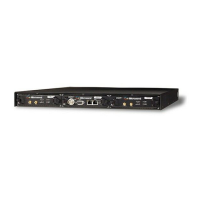097-93100-01 Revision C – February, 2010 TimeCreator 1000 User’s Guide 161
Appendix A Alarms, Events and SNMP Traps
SNMP Traps
See Table A-9 below for additional trap details, such as descriptions and bindings.
The OID for events traps are of the format
Event OID = 1.3.6.1.4.1.9070.1.2.4.1.100.1.y
where y corresponds to index values that identify specific events. The digits shown
for the OID Index in Table A-9 below correspond to y. See Table A-8 for listings of
the full OID for each event.
The event trap is for information only and always has the nonalarm severity.
RSREN
1.3.6.1.4.1.9070.1.2.4.1.100.2.54
trapEnterAutoRecovery
nonalarm
RSREX
1.3.6.1.4.1.9070.1.2.4.1.100.2.55
trapExitAutoRecovery
nonalarm
RSRAB
1.3.6.1.4.1.9070.1.2.4.1.100.2.56
trapAbortAutoRecovery
nonalarm
Note: The ID in the Trap OID Name column in Table A-9 below is
used with the
Generate Message command to raise a specific trap -
tc1000>generate message
“id,trapAID1,trapAID2,trapState,trapValue”
If trapAID1 corresponds to the IOC module number,1 or 2, use the
value trapAID1=257 for IOC1 and trapAID2=258 for IOC2. Use the
number “0” for entries of “n/a”.
Example
To generate the message for the trap “IOC <#> has transitioned in to
Holdover Mode”, which has id=13, trapAID1=258 (corresponds to
trapAID1=2 for IOC2 in
Table A-9) trapAID2=0, trapState=2, and
trapValue=0:
tc1000>generate message “13,258,0,2,0”
Table A-8. TimeCreator 1000 Event Trap Details (Continued)
Trap Name
(trapID)
OID
Trap OID
Name
Trap
Severity

